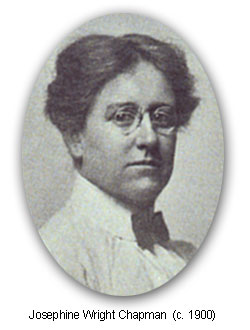 Josephine
Wright Chapman
Josephine
Wright Chapman
Josephine Wright Chapman, 34 years old in 1901, was the only female architect of a Pan-American Exposition building, the New England Building. Nine years earlier, she had left her family's comfortable life in Fitchburg, Massachusetts without her parents' approval. Determined to become an architect, she was forced to secure funds for moving to Boston by pawning her jewelry and some of her clothes. There she apprenticed herself to a noted architect, Clarence Blackall, and by all accounts worked day and night to develop her draftsman and design skills.
In 1898, she opened her own architectural office in Boston. The commission that made her reputation would be the New England Building and she began design work on it as soon as the announcement of the contest for the building appeared in the papers. When she learned that the New England Commission, comprised of governors of all six New England states, was to meet at the Parker House in Boston on a certain date, Chapman appeared there with plans in hand. Her unscheduled presentation won the commission for her.
As was later summarized by the Ladies Home Journal, "To tell the truth of the matter the Governors had but a hazy idea of what was wanted when they started to put up a special building at the Exposition. Miss Chapman, who was evolving some sort of theory as to the importance of an architect's studying her client, had foreseen just such a situation. She told the Governors just what New England needed at Buffalo - she had it down in black and white, in pictures and in plans. That made the whole problem no problem at all for the Governors. They decided that the girl architect knew more than all the men architects put together, and so they went to the theater for the evening. In the morning they sent for Miss Chapman and gave her the job.
"In the spring she went out to Buffalo and superintended the erection of the building. It was a great success. Everyone liked it and said that it reflected great credit upon the six Governors. And they were honest enough to say that it reflected the greatest credit on the smart woman who had designed it."
Josephine Wright Chapman would design women's clubs, a residence at Harvard, a church, and other public buildings for some time and then she decided to concentrate solely on residential design, primarily in the New York City area. She was described as "modest, direct, simple," with "ability, energy, and indomitable faith in herself." (Ladies Home Journal, October 1914). One of only 70 female architects in the United States, she was refused membership into the American Institute of Architects and even the Boston Architectural Club (where her mentor was a founding member) because she was a woman. After moving to New York City and establishing her reputation there, she was invited to join the New York Society of Architects.
She retired in 1925 and moved to Paris, then later to London where her home was destroyed in an air raid in 1940. She died in Bath, England in 1943.
Note: I extend special thanks to Janet Utts who wanted to know more about the woman whose building she was embroidering for a Pan-American quilt. And many, many thanks go to Emily Darling of Preservation Worcester, Massachusetts, my patient and helpful correspondent about Chapman!